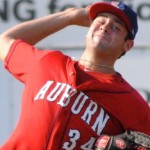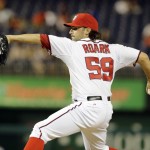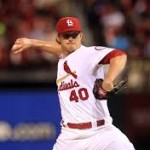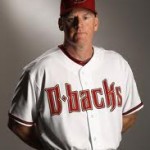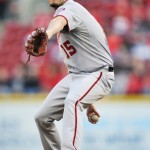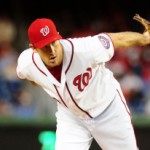
Ohlendorf’s old-school/new-look windup has resurrected his MLB career. Mandatory Credit: Evan Habeeb-USA TODAY Sports
In 2012, the Nats had no less than 10 arbitration candidates once the dust settled on the Super-2 cutoff. The team cut ties with three of the players (Jesus Flores, Tom Gorzelanny and John Lannan) and then subsequently struggled in areas where Gorzelanny (left handed matchups) and Lannan (5th starter) may very well have helped during hte 2013 season. We predicted these three non-tenders and mostly agreed with the thought process behind each decision at the time. This is a complete “hindsight is 20-20” analysis, but it does go to show that perhaps instead of dumping $11M/year onto a mediocre closer they could have fortified their ranks and kept all three players (who together wouldn’t have totaled the $11M Rafael Soriano got) and perhaps wouldn’t have struggled in these areas for so long. Or perhaps not. I digress.
For 2013, the Nats have 8 Arbitration-eligible players. They had a few other candidates before some demotions (Danny Espinosa, Ryan Perry) and releases (Roger Bernadina and Henry Rodriguez) cleared out potential non-tender/additional arbitration candidates early. Unlike last year there’s really not much argument about nearly any of our arbitration-eligible players (even mlbtraderumors does not list any Nats in its non-tender candidate list). Lets take a look at the 8 guys, their 2013 salaries, their 2014 estimates, and discuss. The salary projections are from Matt Swartz‘s mlbtraderumors model, and I’ll discuss if I think they’re slightly over- or under-representative. As with all salary discussions, all information comes from Baseball Prospectus’ Cots page.
| Player | Arb Status | 2013 Salary | 2014 Swartz Estimate |
| Jordan Zimmermann | Arb 3 | $5.3M | $10.5M |
| Tyler Clippard | Arb 3 | $4.0M | $6.2M |
| Stephen Strasburg | Arb 1 | $3.9M | $3.9M |
| Ian Desmond | Arb 2 | $3.8M | $6.9M |
| Drew Storen | Arb 2 | $2.5M | $3.6M |
| Ross Detwiler | Arb 2 | $2.3M | $2.8M |
| Wilson Ramos | Arb 1 | $501k | $2.1M |
| Ross Ohlendorf | Arb 2 | ? | $1.3M |
Frankly, the only possible non-tender candidate I see here is Ross Ohlendorf. He signed a minor league free agency deal with Washington whose terms were never released, so one can only assume it was for the major league minimum or near it. He went through arbitration once already, earning more than $2M/year from Pittsburgh in 2011 before bottoming out as a starter. He’s reinvented himself this year though and merits a tender. Paying anything less than $2M/year for what we got from Ohlendorf would be a bargain. If the Nats got him for Swartz’s estimate of $1.3M that’d be fantastic.
Speaking of Swartz’s estimates, lets take a look at his 10 predictions from last year versus what transpired:
| Swartz’s arb salary model for our 2012 candidates | ||
| Player | Swartz Estimate | Actual Salary |
| John Lannan | $5.0M | NT $2.5M |
| Jordan Zimmermann | $4.9M | $5.3M |
| Tyler Clippard | $4.6M | $4.0M |
| Ian Desmond | $3.2M | $3.8M |
| Tom Gorzelanny | $2.8M | NT $2.6M |
| Ross Detwiler | $2.2M | $2.3M |
| Drew Storen | $1.7M | $2.5M |
| Jesus Flores | $1.2M | NT ML |
| Roger Bernadina | $1.1M | $1.2M |
| Craig Stammen | $900k | $875k* |
(* Stammen signed a 2 yr/2.25M deal paying him 875k and $1.375M his first two arb years. After non tenders Lannan signed a 1yr/$2.5M deal with Philadelphia, Gorzelanny signed a 2yr/$5.7M deal that pays him $2.6M and $2.8M and which gave him a $300k signing bonus. Flores signed a minor league deal).
I’m not sure I’d call Swartz’s model the self-titled “very accurate” based on these numbers. He was significantly wrong on the three biggest cases the Nats faced last year but proved be much more accurate on the lesser players. It sounds to me like his system does a great job of predicting arbitration figures for bit players but struggles with significant players. I also get the feeling that the Nationals are less willing to argue with their players than other teams, after a series of brusing and self-defeating fights over a few hundred thousand dollars under the previous regime (relative pennies, all things considered).
With that in mind, lets do a little arbitration salary analysis for our 8 guys. The general rule of thumb with arbitration salaries is that they are intended to ramp up the full FA value of the player over the three arbitration periods. So in the first arbitration year, the salary should be roughtly 40% of the full FA value. 60% in the second year and 80% in the third year. Players with a fourth year are tricky; generally i’ve just assumed that by the 4th year you’re paying them nearly full FA value (we don’t have any 4th year arbitration cases this year, so we don’t have to guess). The table below contains the Swartz estimates, then has calculations of the player’s full FA value based on the Swartz estimate, then my own personal estimate of each player’s full FA value, and a working-backwards arbitration salary guess for each guy:
| Player | Arb Status | 2013 Salary | 2014 Swartz Estimate | Full FA Value based on Swartz Estimate | My Est of full FA value | Arb estimate based on my full FA value |
| Jordan Zimmermann | Arb 3 | $5.3M | $10.5M | $13.125M | $15M | $12M |
| Tyler Clippard | Arb 3 | $4.0M | $6.2M | $7.75M | $8m | $6.4M |
| Stephen Strasburg | Arb 1 | $3.9M | $3.9M | $9.75M | $15M at least | $6M |
| Ian Desmond | Arb 2 | $3.8M | $6.9M | $11.5M | $15M | $9M |
| Drew Storen | Arb 2 | $2.5M | $3.6M | $6M | $6M | $3.6M |
| Ross Detwiler | Arb 2 | $2.3M | $2.8M | $4.66M | $5M at best | $3M |
| Wilson Ramos | Arb 1 | $501k | $2.1M | $5.25M | $8M if healthy | $3.2M |
| Ross Ohlendorf | Arb 2 | ? | $1.3M | $2.16M | $2.5M at best | $1.5M |
Lets go player by player:
- Jordan Zimmermann: 2013 Salary was $5.3M. Swartz guesses he’ll get $10.5M while I think he’ll get more. If Zimmermann hit the open market right now you have to think he’s at least a $15M/year guy, and I think the team will have to pay him as such after his 2013 season. The Nats face an interesting decision with Zimmermann; they clearly waited one season too long to lock him down and he now may cost double what it cost the team to secure Gio Gonzalez‘s services.
- Tyler Clippard: 2013 salary $4.0M. Swartz guesses he’ll get $6.2M. Clippard represents a different arbitration case; by virtue of the fact that Clippard went from being the 2012 closer to being the 2013 setup guy, he’ll have a harder time arguing for additional money despite his excellent season. Why? Because arbitration is driven by the same old-school stats (Wins, Saves, ERA, RBI) that drive sabrematricians crazy, and unfortunately Clippard didn’t get them in 2013. So even though I think he’s a $8M/year closer for a team that gives him that opportunity, he won’t get that value in arbitration. I’ll be surprised if he gets near to Swartz’s estimate of $6.2M. Honestly the team should look to buy him out of his last two arbitration seasons and look to move him to a team in need of a closer.
- Stephen Strasburg; 2013 Salary $3.9M. Swartz guesses he’ll get $3.9M again? Clearly something is wrong with his system. No matter what you think about Strasburg’s 2013 season … by nearly any measure available he’s one of the 10 best pitchers in the game. If he hit the open market right now I’d guess he’d command at least $20m/year, but for simplicity’s sake I’m putting his FA value at a conservative $15M, which would equate with a $6M valuation for his first arbitration season. Do the Nats just buy him out of his arbitration figures, much as the Giants did with Tim Lincecum?
- Ian Desmond: 2013 salary $3.8M. Swartz guess: $6.9M. Again, I feel like Swartz is undervaluing a significant player here. Desmond has now established himself as one of the best shortstops in the game. If you want a comp, look no further than Elvis Andrus‘s $15M/year contract. I think Desmond is absolutely worth a 6/$90M deal or higher right now, and I think we’ll see it in his arbitration case.
- Drew Storen: 2013 salary $2.5M. Swartz estimate: $3.6M. Here I think Swartz is right on; because Storen’s not getting saves right now, and because of his crummy 2013, I’ve got his FA value pegged at a mid-range closer cost of $6M/year. Which puts him right in line for a $3.6M payday in his second arbitration year. As with Clippard, I think Storen’s value is limited as long as he doesn’t get saves, and the team should look to move him before he gets too expensive.
- Ross Detwiler: 2013 salary $2.3M. Swartz Estimate $2.8M. Frankly Swartz may be over-estimating on Detwiler, based on his 2013 season. At this point in Detwiler’s career its hard to say he’s any more valuable on the FA market than John Lannan was last year (getting a 1yr $2.5M deal). Which means that any arbitration award above $2.5M may mean Detwiler enters non-tender territory if he struggles in 2014. Nonetheless, I think he’ll end up getting just a modest raise and an organizational ultimatum for 2014.
- Wilson Ramos: 2013 salary $501k. Swartz Estimate: $2.1M. Here, despite my thinking that Ramos is eventually going to be more valuable than Swartz’s estimate indicat es, I believe that his number will be about right. Ramos needs to stay on the field consistently to realize his full FA value, and right now that just hasn’t happened.
- Ross Ohlendorf: 2013 salary unknown. Swartz Estimate: $1.3M. This guess is as good as any; at best Ohlendorf is a $2.5M player on the FA market and even that might be a stretch. A right-handed long-relief guy isn’t going to command a ton of money.
Total payroll hit: $37.3M if all of Swartz’s estimates come true exactly. $44.7M if all of my estimates above come true. Honestly I think my calculated estimates are slightly high in a couple of cases, so I think the arbitration bill will come in at around $42.5M. Which, by the way, would put 2014’s payroll at around $122M before signing a single free agent. So think about that and think about what the Nats “real” payroll budget is before thinking that they’ve got some significant signing in their back pocket.
